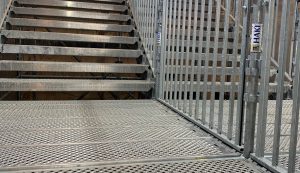Public access safety now a top priority

The scaffolding industry is now seeing a greater demand for public access stairs on construction projects, as a result of the changes to health and safety regulations. On sites where inspections are frequent and emergency access is a priority, it is deemed no longer sufficient to have a small scaffolding stair, but a secure public access alternative which is engineered to the highest degree. Dagfinn Mundal, Country Manager at HAKI AS gives insight into why there is a demand for public access stairs, highlighting the multiple advantages these solutions have to offer.
The Covid-19 pandemic has changed the landscape for many industries. As we all know, social distancing is one of the main ways to prevent the spread of the virus and many companies across the world are now adopting new measures to ensure people can work safely from a distance.
Interest in products which reinforce and enable social distancing will spike as a result of the new safety requirements. But aside from Covid-19, it is important to remember that existing health and safety regulations outline that there needs to be safer emergency and public access across construction, infrastructure, and oil and gas sites. Companies are therefore, looking out for other ways to enable temporary ingress and egress, as traditional scaffolding is no longer hitting the mark in terms of safety.
The continual need for public access stairs is as a result of the daily threats to health and safety on construction and oil and gas sites. These risks can come in the form of slips and trips, falls from height and overcrowding, which is where public access stairs come in. Integrated with cladding, child-safe handrails and solid treads, public access stairs keep people safe and are a secure, robust and sophisticated barrier to physical risk.
As well as preventing the likelihood of falls, public access stairs can also enable crowd management, which is of particular importance when controlling foot traffic.
Public access stairs in action
Public access stairs such as those provided by HAKI therefore, are growing in popularity. With stair widths of up to 2.5m and able to handle loadings of 7.5 kN/m², public access stairs are ideal for sites where high foot traffic is likely. In terms of social distancing the solution satisfies the requirements, as public access stairs provide entrances and exits that maintain the flow of one-way foot traffic.
Speaking on the efficiency of public access stairs, Sigurd Andre Maraas from Kvaerner, leading provider of engineering, procurement and construction (EPC) services, said:
The HAKI Public Access Stairs set a new access standard for our shipyard, Kvaerner Stord. The stairs had been successfully used on a separate project, Johan Sverdrup so we decided to use them again. This stair tower allowed for easy transport of stretchers; were comfortable to use for pedestrians and were dimensioned for the evacuation of large numbers of people. They also fulfilled all of our strict HSE requirements. As such, it will be our preferred stair tower solution going forward.
In terms of application, public access stairs are suitable for all manner of industrial projects. The solution is also ideal for high-trafficked projects such as railways, schools, or shopping malls where temporary emergency access is required to assure safety and minimise disruption to civilian life. In these situations, health and safety regulations stipulate that for safety reasons public access stairs are preferential to small scaffolding stairs, as the latter does not have the capacity to evacuate a sufficient amount of people. HAKI Public Access Stairs (PAS) can accommodate up to 36 people per lift at any single time, with the steel structures engineered in a way which negates the likelihood of component replacement. High-performing, durable, and characteristic of minimalist Scandinavian engineering, public access stairs are more than a safe bet when it comes to creating temporary access solutions onsite.
The switch to public access stairs marks a step-change for industries, particularly as it has been somewhat customary to use traditional scaffolding. In order to satisfy the regulations however, new technologies are the answer. At present, older solutions are falling short when it comes to providing safe ingress and egress; unable to efficiently handle the loads that are required on a project. It is also worth bearing in mind that if a second wave of the coronavirus hits, products which enable social distancing will be urgently needed. It’s why it always pays-off to be proactive and pre-empt what might come – it might be the difference between a safe and unsafe construction site.
 Haki has now acquired vertemax – Discover the
Haki has now acquired vertemax – Discover the 